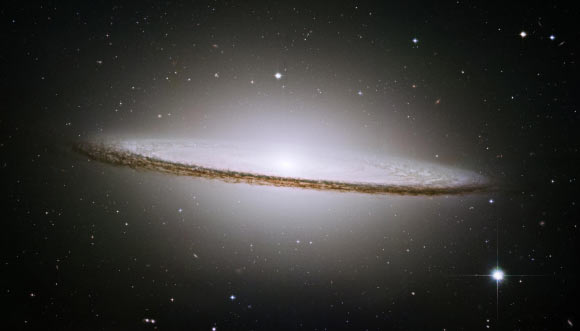According to Australian National University astrobiologists Charley Lineweaver and Aditya Chopra, life on other planets would likely be brief and become extinct very quickly.

This image from Hubble shows the Sombrero Galaxy (also known as Messier 104 or NGC 4594), an unbarred spiral galaxy located about 29 million light-years away. Image credit: NASA / Hubble Heritage Team.
“The Universe is probably filled with habitable planets, so many scientists think it should be teeming with aliens. Early life is fragile, so we believe it rarely evolves quickly enough to survive,” said Dr Chopra, who is the first author of a paper in the journal Astrobiology.
“Most early planetary environments are unstable. To produce a habitable planet, life forms need to regulate greenhouse gases such as water and carbon dioxide to keep surface temperatures stable.”
About 4 billion years ago Earth and other terrestrial planets in our Solar System may have all been habitable.
However, a billion years or so after formation, Venus turned into a hothouse and Mars froze into an icebox. Early microbial life on these two planets, if there was any, failed to stabilize the rapidly changing environment, according to Prof. Lineweaver. “Life on Earth probably played a leading role in stabilizing the planet’s climate.”
Dr Chopra said their theory “solved a puzzle. The mystery of why we haven’t yet found signs of aliens may have less to do with the likelihood of the origin of life or intelligence and have more to do with the rarity of the rapid emergence of biological regulation of feedback cycles on planetary surfaces.”
On wet terrestrial planets, with the ingredients and energy sources required for life seem to be ubiquitous, however, as physicist Enrico Fermi pointed out in 1950, no signs of surviving extraterrestrial life have been found.
A plausible solution to Fermi’s paradox is near universal early extinction, which the scientists have named the Gaian bottleneck.
“The prerequisites and ingredients for life seem to be abundantly available in the Universe. However, the Universe does not seem to be teeming with life. The most common explanation for this is a low probability for the emergence of life (an emergence bottleneck), notionally due to the intricacies of the molecular recipe,” the astrobiologists said.
“We present an alternative Gaian bottleneck explanation: if life emerges on a planet, it only rarely evolves quickly enough to regulate greenhouse gases and albedo, thereby maintaining surface temperatures compatible with liquid water and habitability.”
“Such a Gaian bottleneck suggests that (i) extinction is the cosmic default for most life that has ever emerged on the surfaces of wet rocky planets in the Universe and (ii) rocky planets need to be inhabited to remain habitable.”
_____
Chopra Aditya & Lineweaver H. Charles. 2016. The Case for a Gaian Bottleneck: The Biology of Habitability. Astrobiology 16 (1): 7-22; doi: 10.1089/ast.2015.1387







